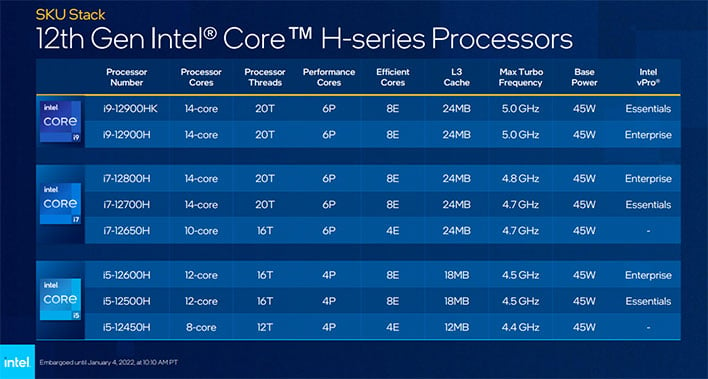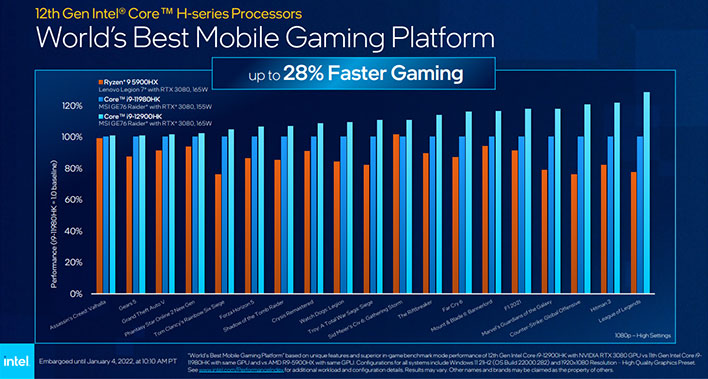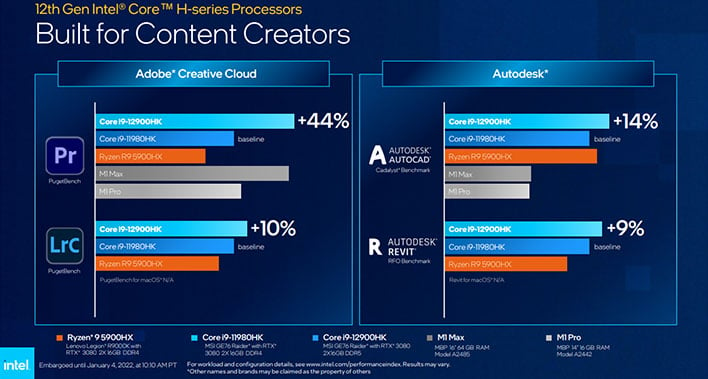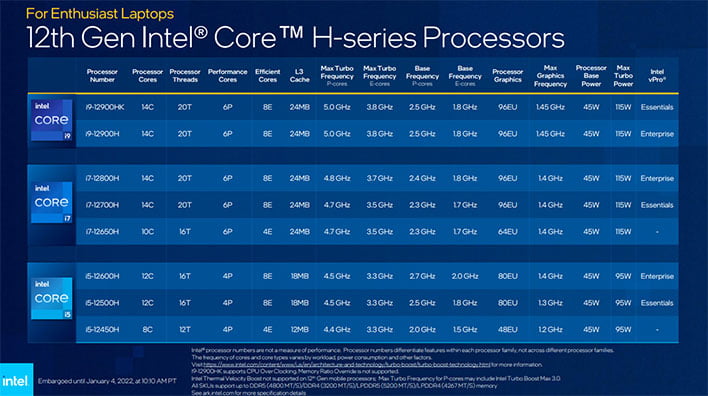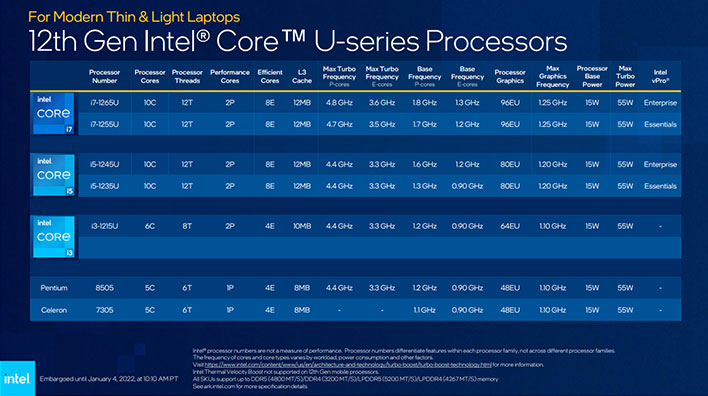It was inevitable that Intel would release laptop processors based on its
Alder Lake architecture, and that day has officially arrived. As it did on the desktop, Intel is kicking things off with its high-performance parts, which in this case its its 12th Gen Core H-series lineup, with up to 14 physical cores and 20 threads. Lower power options will be coming at some point in the future.
Intel's mobile Alder Lake stack is headlined by the Core i9-12900HK, and the company is making no bones about what it says this chip represents: "The fastest mobile processor. Ever." It's also touting huge gains in gaming, which we'll get to in a moment.
Sporting the same hybrid design as its higher end desktop chips, all of the 12th Gen Core H-series chips announced today combine high-performance P-cores (Golden Cove) with power efficient E-cores (Gracemont), but in a mobile package. Intel also just announced additional desktop SKUs at lower wattages, several of which are comprised entirely of P-cores. We imagine Intel will do the same with its laptop lineup at some point, but today is not that day.
Here's a look at the SKUs...
Click to Enlarge

There are eight processors headlined by the Core i9-12900HK and Core i9-12900H, followed by the Core i7-12800H, Core i7-12700H, and Core i7-12650H, then finally the Core i5-12600H, Core i5-12500H, and Core i5-12450H.
All of these will find their way into performance laptop designs, where they will provide 12th Gen bite for gaming, content creation, and other demanding workloads. The two Core i9 SKUs feature a 14-core/20-thread design comprised of six P-cores and eight E-cores, a max 5GHz turbo frequency, and 24MB of L3 cache. The Core i9-12900HK has the added luxury of unlocked multipliers for larger laptops that can accommodate overclocking.
At the other end of the spectrum, the Core i5-12450H is the entry-level SKU (so far), but it is no slouch. It's still an 8-core/12-thread chip, split between four P-cores and four E-cores, with a max 4.4GHz turbo frequency and 12MB of L3 cache.
Click to Enlarge
According to Intel's own benchmarks, the flagship SKU delivers up to 28 percent faster gaming, a claim that appears rooted in League of Legends. Across the board, Intel's benchmark data showcases anywhere from marginal victories over the previous generation
Core i9-11980HK, to more substantial gains. And compared to AMD's Ryzen 9 5900HX, Intel's benchmarks show mostly wide performance gaps in Intel's curated selection of games, such as Marvel's Guardian's of the Galaxy, The Riftbreaker, Hitman 3, and several others.
 Click to Enlarge
Click to Enlarge
Intel is claiming even bigger performance gaps in content creation chores—up to 44 percent in Adobe Creative Cloud and 30 percent in Blender, compared to the Core i9-11980HK. These are massive leaps if they hold true. That's something we'll examine when get a chance to test Intel's latest mobile silicon, but as we've seen on the desktop, Alder Lake is a stout architecture.
You shouldn't have to wait long to find out, though. Intel says there are already more than 100 designs in play from its hardware partners, spanning ultraportable, thin enthusiast, and halo enthusiast laptops from the usual suspects (ASUS, Dell, MSI, Razer, and others). According to Intel, this generation will mark its fastest H-series ramp to date.
Intel Unveils 12th Gen Core P-Series And U-Series CPUs For Lower Power Laptops
Intel is also rolling out a range of lower power Alder Lake processors for ultra-thin and light laptops, and other notebooks that would benefit from a smaller power envelope.
 Click to Enlarge
Click to Enlarge
Starting with the newly unveiled 12th Gen Core P-series, Intel introduced half a dozen SKUs, each one with a base 28W TPD and a 64W max turbo TDP. These are all hybrid chips too, culminating in the 14-core/20-thread Core i7-1280P.
That's right, we get a bit of a simplified model designation with this series. The top chip sports six P-cores with a 1.8GHz base clock and 4.8GHz max turbo frequency, and eight E-cores clocked at 1.3GHz to 3.6GHz. It also wields 24MB of L3 cache (the most of the P-series) and integrated Xe graphics with 96 execution units running at up to 1.45GHz.
On the other end of the spectrum, the Core i3-1220P is a 10-core/12-thread chip with two P-cores clocked at 1.5GHz to 4.4GHz, and eight E-cores clocked at 1.1GHz to 3.3GHz. So it's back loaded on the hybrid configuration to prioritize efficiency, but still offers up some higher performing cores to crunch more demanding workloads.
Several Core i5 and Core i7 SKUs are sandwiched in between, as outlined in the slide above. It will be interesting to see how these perform in upcoming laptop models, with the lineup taking aim at more performant thin and light systems.
 Click to Enlarge
Click to Enlarge
Finally, we have the new 12th Gen Core U-series for ultra-thin and light laptops where power efficiency is key, given that there is only so much cooling potential in such systems. There are seven processors in all, each with a 15W base TDP and 55W max turbo TDP.
There are five SKUs spanning the Core i7, Core i5, and Core i3 families, all of which also back load the core configuration. The Core i7-1265U sits at the top of the stack with a 10-core/12-thread configuration. They consist of two P-cores clocked at 1.8GHz to 4.8GHz, and eight E-cores clocked at 1.3GHz to 3.6GHz. It also features 12MB of L3 cache and integrated Xe graphics with 96 EUs clocked at 1.25GHz.
At the other end, we have the Core i3-1215U with a 6-core/8-thread configuration. It consists of two P-cores clocked at 1.2GHz to 4.4GHz and four E-cores clocked at 900MHz to 3.3GHz. On the Xe side, there are 64 EUs clocked at 1.1GHz.
Then at the bottom, we have the Celeron 7305 and Pentium 8505, both of which are single P-core designs, which are propped up with four E-cores.
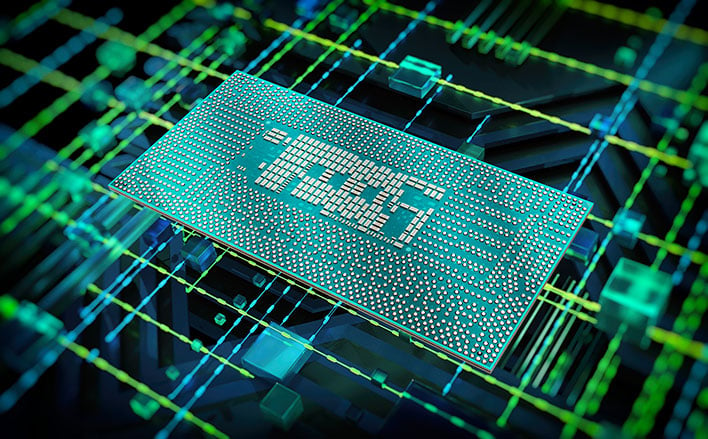
 There are eight processors headlined by the Core i9-12900HK and Core i9-12900H, followed by the Core i7-12800H, Core i7-12700H, and Core i7-12650H, then finally the Core i5-12600H, Core i5-12500H, and Core i5-12450H.
There are eight processors headlined by the Core i9-12900HK and Core i9-12900H, followed by the Core i7-12800H, Core i7-12700H, and Core i7-12650H, then finally the Core i5-12600H, Core i5-12500H, and Core i5-12450H.
